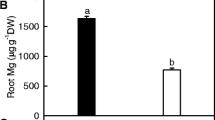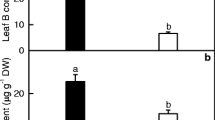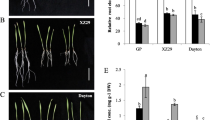Abstract
Self-germinated seedlings of Citrus sinensis and C. grandis were supplied with nutrient solution with 0 mM AlCl3·6H2O (control, −Al) or 1 mM AlCl3·6H2O (+Al) for 18 weeks. The DW (Dry weights) of leaf, stem, shoot and the whole plant of C. grandis were decreased and the ratio of root DW to shoot DW in C. grandis were increased by Al, whereas these parameters of C. sinensis were not changed by Al. Al treatment dramatically decreased the sulfur (S) content in C. grandis roots and the phosphorus (P) content in both C. sinensis and C. grandis roots. More Al was transported to shoots and leaves in C. grandis than in C. sinensis under Al treatment. Al treatment has more adverse effects on C. grandis than on C. sinensis, as revealed by the higher production of superoxide anion (O·−2 ), H2O2 and thiobarbituric acid reactive substace (TBARS) content in C. grandis roots. Via the Illumina sequencing technique, we successfully identified and quantified 12 and 16 differentially expressed miRNAs responding to Al stress in C. sinensis and C. grandis roots, respectively. The possible mechanism underlying different Al tolerance of C. sinensis and C. grandis were summarized as having following aspects: (a) enhancement of adventitious and lateral root development (miR160); (b) up-regulation of stress and signaling transduction related genes, such as SGT1, PLC and AAO (miR477, miR397 and miR398); (c) enhancement of citrate secretion (miR3627); (d) more flexible control of alternative glycolysis pathway and TCA cycle (miR3627 and miR482); (e) up-regulation of S-metabolism (miR172); (f) more flexible control of miRNA metabolism. For the first time, we showed that root development (miR160) and cell wall components (cas-miR5139, csi-miR12105) may play crucial roles in Al tolerance in citrus plants. In conclusion, our study provided a comprehensive profile of differentially expressed miRNAs in response to Al stress between two citrus plants differing in Al tolerance which further enriched our understanding of the molecular mechanism underlying Al tolerance in plants.







Similar content being viewed by others
Data availability
The RNA-seq data was deposited in NCBI database (https://www.ncbi.nlm.nih.gov/sra/) with SRA accession number PRJNA600689.
References
Ames BN (1966) Assay of inorganic phosphate, total phosphate and phosphatase. Methods Enzymol 8:115–118
Chang YC, Yamamoto Y, Matsumoto H (1999) Accumulation of aluminium in the cell wall pectin in cultured tobacco (Nicotiana tabacum L.) cells treated with a combination of aluminium and iron. Plant Cell Environ 22:1009–1017
Chen X (2005) microRNA biogenesis and function in plants. FEBS Lett 579:5923–5931
Chen JH, Lin YH (2010) Effect of aluminum on variations in the proteins in pineapple roots. Soil Sci Plant Nutr 56:438–444
Chen Q, Guo CL, Wang P, Chen XQ, Wu KH, Li KZ, Yu YX, Chen LM (2013) Up-regulation and interaction of the plasma membrane H + -ATPase and the 14-3-3 protein are involved in the regulation of citrate exudation from the broad bean (Vicia faba L.) under Al stress. Plant Physiol Biochem 70:504–511
Chen Q, Kan Q, Wang P, Yu WQ, Yu YZ, Zhao Y, Yu YX, Li KZ, Chen LM (2015) Phosphorylation and interaction with the 14-3-3 protein of the plasma membrane H+-ATPase are involved in the regulation of magnesium-mediated increases in aluminum-induced citrate exudation in broad bean (Vicia faba L). Plant Cell Physiol 56:1144–1153
Chen C, Zeng Z, Liu Z, Xia R (2018) Small RNAs, emerging regulators critical for the development of horticultural traits. Hortic Res 5:63
Chiou TJ, Lin SI (2011) Signaling network in sensing phosphate availability in Plants. Ann Rev Plant Biol 62:185–206
Doke N (1983) Involvement of superoxide anion generation in the hypersensitive response of potato tuber tissues to infection with an incompatible race of Phytophthora infestans and to the hyphal wall components. Physiol Plant Pathol 23:345–357
Dong Z, Han MH, Fedoroff N (2008) The RNA-binding proteins HYL1 and SE promote accurate in vitro processing of pri-miRNA by DCL1. Proc Natl Acad Sci USA 105:9970–9975
Guo P, Li Q, Qi YP, Yang LT, Ye X, Chen HH, Chen LS (2017a) Sulfur-mediated-alleviation of aluminum-toxicity in Citrus grandis seedlings. Int J Mol Sci 18:2570
Guo P, Qi YP, Yang LT, Lai NW, Ye X, Yang Y, Chen LS (2017b) Root adaptive responses to aluminum-treatment revealed by RNA-seq in two citrus species with different aluminum-tolerance. Front Plant Sci 8:330
Guo P, Qi YP, Cai YT, Yang TY, Yang LT, Huang ZR, Chen LS (2018) Aluminum effects on photosynthesis, reactive oxygen species and methylglyoxal detoxification in two Citrus species differing in aluminum tolerance. Tree Physiol 38:1548–1565
Gutierrez L, Bussell JD, Păcurar DI, Schwambach J, Păcurar M, Bellini C (2009) Phenotypic plasticity of adventitious rooting in Arabidopsis is controlled by complex regulation of AUXIN RESPONSE FACTOR transcripts and microRNA abundance. Plant Cell 21:3119–3132
He H, He L, Gu M (2014) Role of microRNAs in aluminum stress in plants. Plant Cell Rep 33:831–836
Heim A, Brunner I, Frey B, Frossard E, Luster J (2001) Root exudation, organic acids, and element distribution in roots of Norway spruce seedlings treated with aluminum in hydroponics. J Plant Nutr Soil Sci 164:519–526
Hodges DM, DeLong JM, Forney CF, Prange RK (1999) Improving the thiobarbituric acid-reactive-substances assay for estimating lipid peroxidation in plant tissues containing anthocyanin and other interfering compounds. Planta 207:604–611
Hsu PH (1963) Effect of initial pH, phosphate, and silicate on the determination of aluminum with aluminon. Soil Sci 96:230–238
Huang SQ, Xiang AL, Che LL, Chen S, Li H, Song JB, Yang ZM (2010) A set of miRNAs from Brassica napus in response to sulphate deficiency and cadmium stress. Plant Biotechnol J 8:887–899
Huang JH, Qi YP, Wen SX, Guo P, Chen XM, Chen LS (2016) Illumina microRNA profiles reveal the involvement of miR397a in Citrus adaptation to long-term boron toxicity via modulating secondary cell-wall biosynthesis. Sci Rep 6:22900
Huang SC, Lu GH, Tang CY, Ji YJ, Tan GS, Hu DQ, Cheng J, Wang GH, Qi JL, Yang YH (2018) Identification and comparative analysis of aluminum-induced microRNAs conferring plant tolerance to aluminum stress in soybean. Biol Plantarum 62:97–108
Jagadeeswaran G, Zheng Y, Li YF, Shukla LI, Matts J, Hoyt P, Macmil SL, Wiley GB, Roe BA, Zhang W, Sunkar R (2009) Cloning and characterization of small RNAs from Medicago truncatula reveals four novel legume-specific microRNA families. New Phytol 184:85–98
Janhunen S, Palomäki V, Holopainen T (1995) Aluminium causes nutrient imbalance and structural changes in the needles of Scots pine without inducing clear root injuries. Trees 9:134
Jaskowiak J, Tkaczyk O, Slota M, Kwasniewska J, Szarejko I (2018) Analysis of aluminum toxicity in Hordeum vulgare roots with an emphasis on DNA integrity and cell cycle. PLoS ONE 13:e0193156
Jiang HX, Yang LT, Qi YP, Lu YB, Huang ZR, Chen LS (2015) Root iTRAQ protein profile analysis of two Citrus species differing in aluminum-tolerance in response to long-term aluminum-toxicity. BMC Genom 16:949
Jin XL, Ma CL, Yang LT, Chen LS (2016) Alterations of physiology and gene expression due to long-term magnesium-deficiency differ between leaves and roots of Citrus reticulata. J Plant Physiol 198:103–115
Johnson AH, Siccama TG (1983) Acid deposition and forest decline. Environ Sci Technol 17:294A–305A
Jones-Rhoades MW, Bartel DP (2004) Computational identification of plant microRNAs and their targets, including a stress-induced miRNA. Mol Cell 14:787–799
Kant S, Peng M, Rothstein SJ (2011) Genetic regulation by NLA and microRNA827 for maintaining nitrate-dependent phosphate homeostasis in Arabidopsis. PLoS Genet 7:e1002021
Kato N, Esaka M (1999) Changes in ascorbate oxidase gene expression and ascorbate levels in cell division and cell elongation in tobacco cells. Physiol Plantarum 105:321–329
Kinraide TB (1991) Identity of the rhizotoxic aluminium species. Plant Soil 134:167–178
Kong X, Zhang M, Xu X, Li X, Li C, Ding Z (2014) System analysis of microRNAs in the development and aluminium stress responses of the maize root system. Plant Biotechnol J 12:1108–1121
Kumari M, Taylor GJ, Deyholos MK (2008) Transcriptomic responses to aluminum stress in roots of Arabidopsis thaliana. Mol Genet Genom 279:339–357
Kuo HF, Chiou TJ (2011) The role of MicroRNAs in phosphorus deficiency signaling. Plant Physiol 156:1016–1024
Larsen PB, Geisler MJB, Jones CA, Williams KM, Cancel JD (2005) ALS3 encodes a phloem-localized ABC transporter-like protein that is required for aluminum tolerance in Arabidopsis. Plant J 41:353–363
Larssen T, Carmichael GR (2000) Acid rain and acidification in China: the importance of base cation deposition. Environ Pollut 110:89–102
Li Y, Zhang Q, Zhang J, Wu L, Qi Y, Zhou JM (2010) Identification of microRNAs involved in pathogen-associated molecular pattern-triggered plant innate immunity. Plant Physiol 152:2222–2231
Li XS, Bai TT, Li YF, Ruan XL, Li HP (2013) Proteomic analysis of Fusarium oxysporum f. sp. cubense tropical race 4-inoculated response to Fusarium wilts in the banana root cells. Proteome Sci 11:41
Li Y, Han MQ, Lin F, Ten Y, Lin J, Zhu DH, Guo P, Weng YB, Chen LS (2015) Soil chemical properties, ‘Guanximiyou’ pummelo leaf mineral nutrient status and fruit quality in the southern region of Fujian province, China. J Soil Sci Plant Nutr 15:263–269
Li S, Shao Z, Fu X, Xiao W, Li L, Chen M, Sun M, Li D, Gao D (2017) Identification and characterization of Prunus persica miRNAs in response to UVB radiation in greenhouse through high-throughput sequencing. BMC Genom 18:938
Liang G, He H, Yu D (2012) Identification of nitrogen starvation-responsive microRNAs in Arabidopsis thaliana. PLoS ONE 7:e48951
Liu MY, Lou HQ, Chen WW, Piñeros MA, Xu JM, Fan W, Kochian LV, Zheng SJ, Yang JL (2018) Two citrate transporters coordinately regulate citrate secretion from rice bean root tip under aluminum stress. Plant Cell Environ 41:809–822
Long A, Zhang J, Yang LT, Ye X, Lai NW, Tan LL, Lin D, Chen LS (2017) Effects of low pH on photosynthesis, related physiological parameters, and nutrient profiles of citrus. Front Plant Sci 8:185
Lu YB, Yang LT, Qi YP, Li Y, Li Z, Chen YB, Huang ZR, Chen LS (2014) Identification of boron-deficiency-responsive microRNAs in Citrus sinensis roots by Illumina sequencing. BMC Plant Biol 14:123
Magalhaes JV, Liu J, Guimarães CT, Lana UGP, Alves VMC, Wang YH, Schaffert RE, Hoekenga OA, Piñeros MA, Shaff JE, Klein PE, Carneiro NP, Coelho CM, Trick HN, Kochian LV (2007) A gene in the multidrug and toxic compound extrusion (MATE) family confers aluminum tolerance in sorghum. Nat Genet 39:1156
Meng Y, Huang F, Shi Q, Cao J, Chen D, Zhang J, Ni J, Wu P, Chen M (2009) Genome-wide survey of rice microRNAs and microRNA–target pairs in the root of a novel auxin-resistant mutant. Planta 230:883–898
Naya L, Paul S, Valdes-Lopez O, Mendoza-Soto AB, Nova-Franco B, Sosa-Valencia G, Reyes JL, Hernandez G (2014) Regulation of copper homeostasis and biotic interactions by microRNA 398b in common bean. PLoS ONE 9:e84416
Negishi T, Oshima K, Hattori M, Kanai M, Mano S, Nishimura M, Yoshida K (2012) Tonoplast- and plasma membrane-localized aquaporin-family transporters in blue hydrangea sepals of aluminum hyperaccumulating plant. PLoS ONE 7:e43189
Negishi T, Oshima K, Hattori M, Yoshida K (2013) Plasma membrane-localized Al-transporter from blue hydrangea sepals is a member of the anion permease family. Genes Cells 18:341–352
Oh MW, Roy SK, Kamal AH, Cho K, Cho SW, Park CS, Choi JS, Komatsu S, Woo SH (2014) Proteome analysis of roots of wheat seedlings under aluminum stress. Mol Biol Rep 41:671
Osawa H, Endo I, Hara Y, Matsushima Y, Tange T (2011) Transient proliferation of proanthocyanidin-accumulating cells on the epidermal apex contributes to highly aluminum-resistant root elongation in camphor tree. Plant Physiol 155:433–446
Pereira JF, Zhou G, Delhaize E, Richardson T, Zhou M, Ryan PR (2010) Engineering greater aluminium resistance in wheat by over-expressing TaALMT1. Ann Bot 106:205–214
Sasaki T, Yamamoto Y, Ezaki B, Katsuhara M, Ahn SJ, Ryan PR, Delhaize E, Matsumoto H (2004) A wheat gene encoding an aluminum-activated malate transporter. Plant J 37:645–653
Shao JF, Che J, Chen RF, Ma JF, Shen RF (2015) Effect of in planta phosphorus on aluminum-induced inhibition of root elongation in wheat. Plant Soil 395:307–315
Shen C, Huang YY, He CT, Zhou Q, Chen JX, Tan X, Mubeen S, Yuan JG, Yang ZY (2017) Comparative analysis of cadmium responsive microRNAs in roots of two Ipomoea aquatica Forsk. cultivars with different cadmium accumulation capacities. Plant Physiol Biochem 111:329–339
Singh A, Bhatnagar N, Pandey A, Pandey GK (2015) Plant phospholipase C family: Regulation and functional role in lipid signaling. Cell Calcium 58:139–146
Tiwari SB, Hagen G, Guilfoyle T (2003) The roles of auxin response factor domains in auxin-responsive transcription. Plant Cell 15:533–543
von Uexküll HR, Mutert E (1995) Global extent, development and economic impact of acid soils. Plant Soil 171:1–15
Wang CY, Shen RF, Wang C, Wang W (2013) Root protein profile changes induced by Al exposure in two rice cultivars differing in Al tolerance. J Proteom 78:281–293
Wang H, Chen RF, Iwashita T, Shen RF, Ma JF (2014a) Physiological characterization of aluminum tolerance and accumulation in tartary and wild buckwheat. New Phytol 205:273–279
Wang ZQ, Xu XY, Gong QQ, Xie C, Fan W, Yang JL, Lin QS, Zheng SJ (2014b) Root proteome of rice studied by iTRAQ provides integrated insight into aluminum stress tolerance mechanisms in plants. J Proteom 98:189–205
Wei F, He QL, Yu LG, Mei YL, Meng JC, Yu L, Jian LY, Shao JZ (2015) Characterization of an inducible C2H2-type zinc finger transcription factor VuSTOP1 in rice bean (Vigna umbellata) reveals differential regulation between low pH and aluminum tolerance mechanisms. New Phytol 208:456–468
Wu YM, Wang YY, Zhou YF, Meng X, Huang ZR, Chen LS, Yang LT (2019) Analysis of interacting proteins of aluminum toxicity response factor ALS3 and CAD in Citrus. Int J Mol Sci 20:4846
Xie F, Wang Q, Sun R, Zhang B (2015) Deep sequencing reveals important roles of microRNAs in response to drought and salinity stress in cotton. J Exp Bot 66:789–804
Yamamoto Y, Kobayashi Y, Devi SR, Rikiishi S, Matsumoto H (2003) Oxidative stress triggered by aluminum in plant roots. Plant Soil 255:239–243
Yang YL, Li XM (2000) The IAP family: endogenous caspase inhibitors with multiple biological activities. Cell Res 10:169–177
Yang LT, Jiang HX, Tang N, Chen LS (2011) Mechanisms of aluminum-tolerance in two species of citrus: secretion of organic acid anions and immobilization of aluminum by phosphorus in roots. Plant Sci 180:521–530
Yang LT, Jiang HX, Qi YP, Chen LS (2012) Differential expression of genes involved in alternative glycolytic pathways, phosphorus scavenging and recycling in response to aluminum and phosphorus interactions in Citrus roots. Mol Biol Rep 39:6353–6366
Yang LT, Liu JW, Wu YM, Qi YP, Wang JL, Lai NW, Ye X, Chen LS (2018) Proteome profile analysis of boron-induced alleviation of aluminum-toxicity in Citrus grandis roots. Ecotox Environ Saf 162:488–498
Yang LT, Zhou YF, Wang YY, Wu YM, Qian B, Wang H, Chen LS (2019) Phosphorus-mediated alleviation of aluminum toxicity revealed by the iTRAQ technique in Citrus grandis roots. PLoS ONE 14:e0223516
Ye Q, Wang H, Su T, Wu WH, Chen YF (2018) The ubiquitin E3 ligase PRU1 regulates WRKY6 degradation to modulate phosphate homeostasis in response to low-Pi stress in Arabidopsis. Plant Cell 30:1062–1076
Yusof NA, Hashim NHF, Beddoe T, Mahadi NM, Illias RM, Bakar FDA, Murad AMA (2016) Thermotolerance and molecular chaperone function of an SGT1-like protein from the psychrophilic yeast, Glaciozyma antarctica. Cell Stress Chaperon 21:707–715
Zeng H, Wang G, Hu X, Wang H, Du L, Zhu Y (2014) Role of microRNAs in plant responses to nutrient stress. Plant Soil 374:1005–1021
Zhang J, Wei J, Li D, Kong X, Rengel Z, Chen L, Yang Y, Cui X, Chen Q (2017) The role of the plasma membrane H+-ATPase in plant responses to aluminum toxicity. Front Plant Sci 8:1757
Zhao M, Ding H, Zhu JK, Zhang F, Li WX (2011) Involvement of miR169 in the nitrogen-starvation responses in Arabidopsis. New Phytol 190:906–915
Zhao M, Tai H, Sun S, Zhang F, Xu Y, Li WX (2012) Cloning and characterization of maize miRNAs involved in responses to nitrogen deficiency. PLoS ONE 7:e29669
Zhen Y, Qi JL, Wang SS, Su J, Xu GH, Zhang MS, Miao L, Peng XX, Tian DC, Yang YH (2007) Comparative proteome analysis of differentially expressed proteins induced by Al toxicity in soybean. Physiol Plantarum 131:542–545
Zhou D, Yang Y, Zhang J, Jiang F, Craft E, Thannhauser TW, Kochian LV, Liu J (2017) Quantitative iTRAQ proteomics revealed possible roles for antioxidant proteins in sorghum aluminum tolerance. Front Plant Sci 7:2043
Funding
This study was financially supported by the National Key R&D Program of China (No. 2017YFD0202000), the National Natural Science Foundation of China (No. 31301740).
Author information
Authors and Affiliations
Corresponding author
Ethics declarations
Conflict of interest
The authors declare no conflict of interest.
Additional information
Publisher's Note
Springer Nature remains neutral with regard to jurisdictional claims in published maps and institutional affiliations.
Electronic supplementary material
Below is the link to the electronic supplementary material.
Rights and permissions
About this article
Cite this article
Zhou, YF., Wang, YY., Chen, WW. et al. Illumina sequencing revealed roles of microRNAs in different aluminum tolerance of two citrus species. Physiol Mol Biol Plants 26, 2173–2187 (2020). https://doi.org/10.1007/s12298-020-00895-y
Received:
Revised:
Accepted:
Published:
Issue Date:
DOI: https://doi.org/10.1007/s12298-020-00895-y




